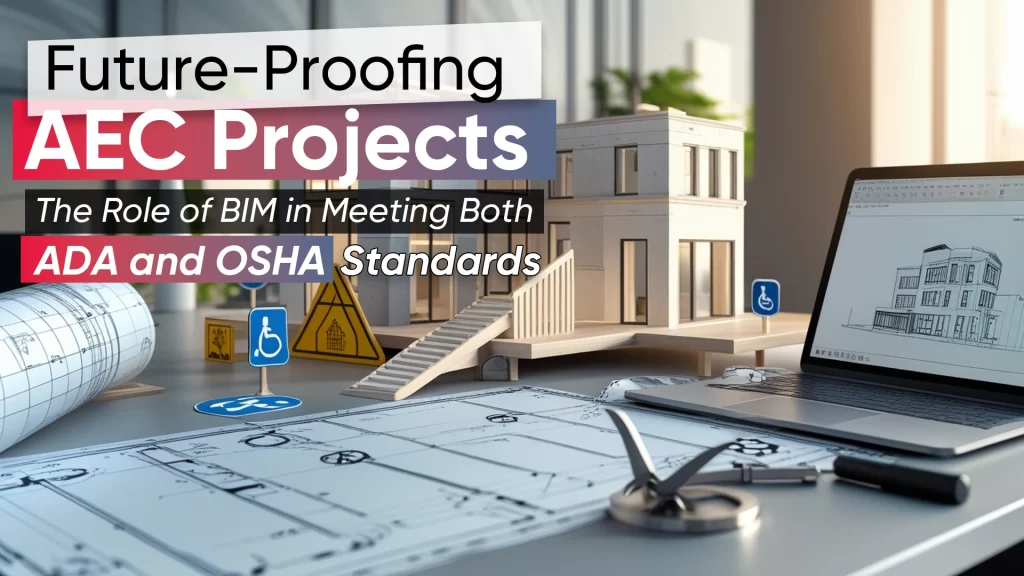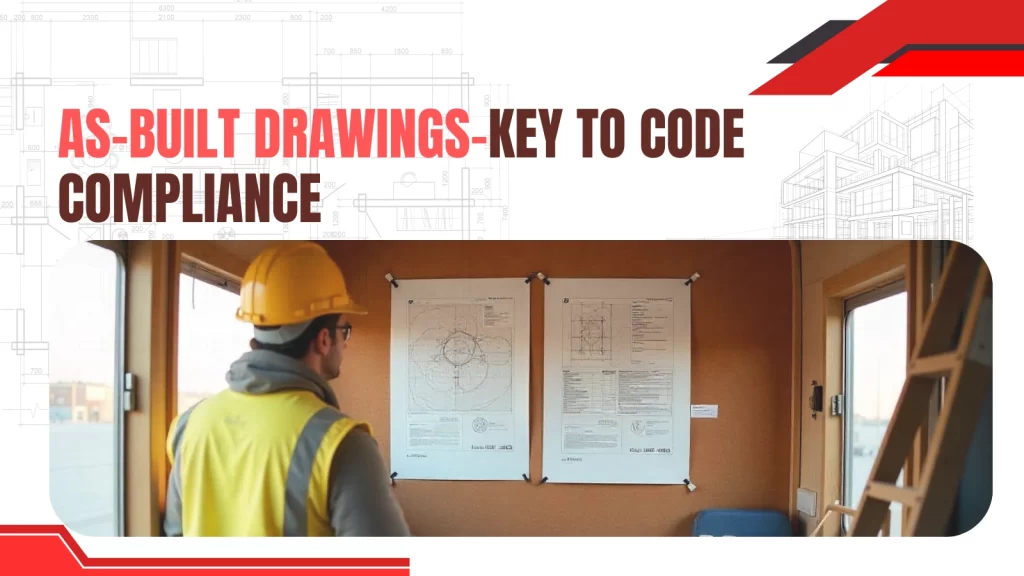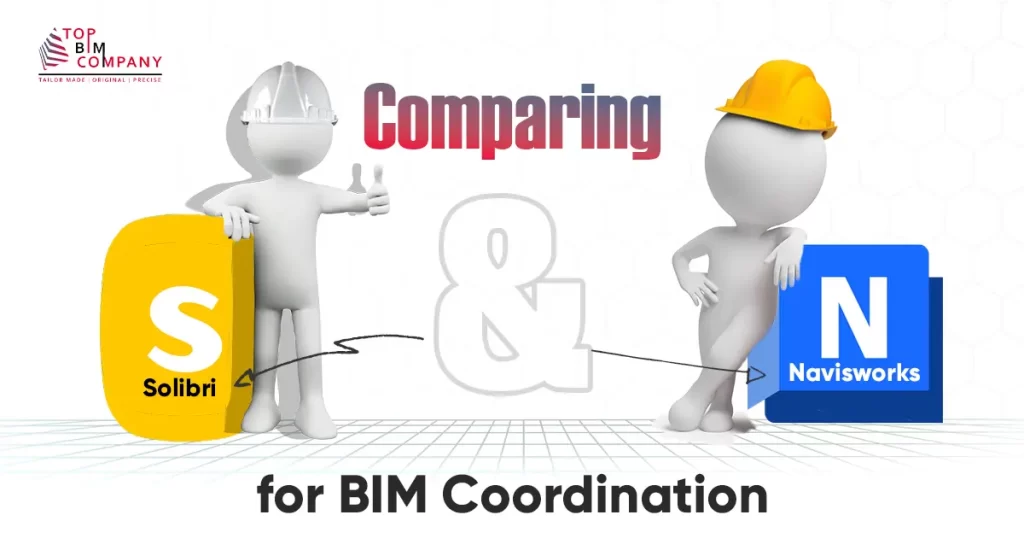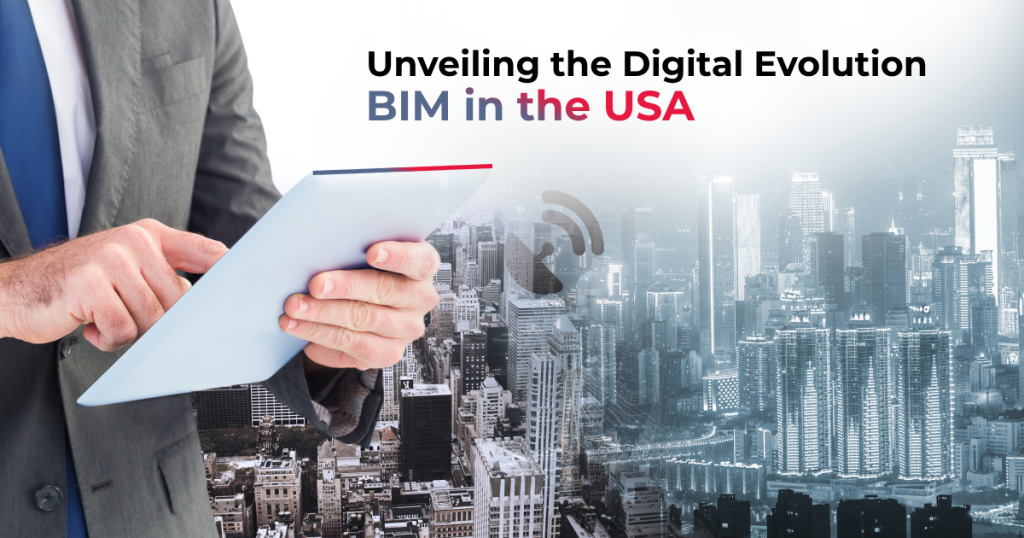
The construction industry in the United States is experiencing a digital revolution fueled by the widespread adoption of Building Information Modeling (BIM). This transformative technology has redefined the landscape of construction, influencing the design, construction, and management of buildings. According to alliedmarketresearch, the global BIM market is poised to reach $15,892 million by 2027, with a remarkable growth rate of 15.2%. Notably, in North America, the Compound Annual Growth Rate (CAGR) is projected at 13.2% from 2022 to 2027.
Table of Contents
ToggleYou May Like to Read:
How is BIM Growing in Europe Construction Industry?
How is BIM Growing in the Indian construction industry?
Let’s explore the surging growth of BIM in the USA and its profound impact on various facets of the construction industry.
Unveiling the Digital Evolution: BIM in the USA:
BIM is a process that involves creating a digital model of a building, containing all the physical and functional information about the structure. This model serves as a central hub for collaboration and information sharing among all stakeholders involved in the building project, from architects and engineers to contractors and facility managers.
The American Construction Renaissance:
The adoption of BIM in the USA has been nothing short of remarkable, with the country emerging as a global leader in this field. This surge can be attributed to several factors, including:
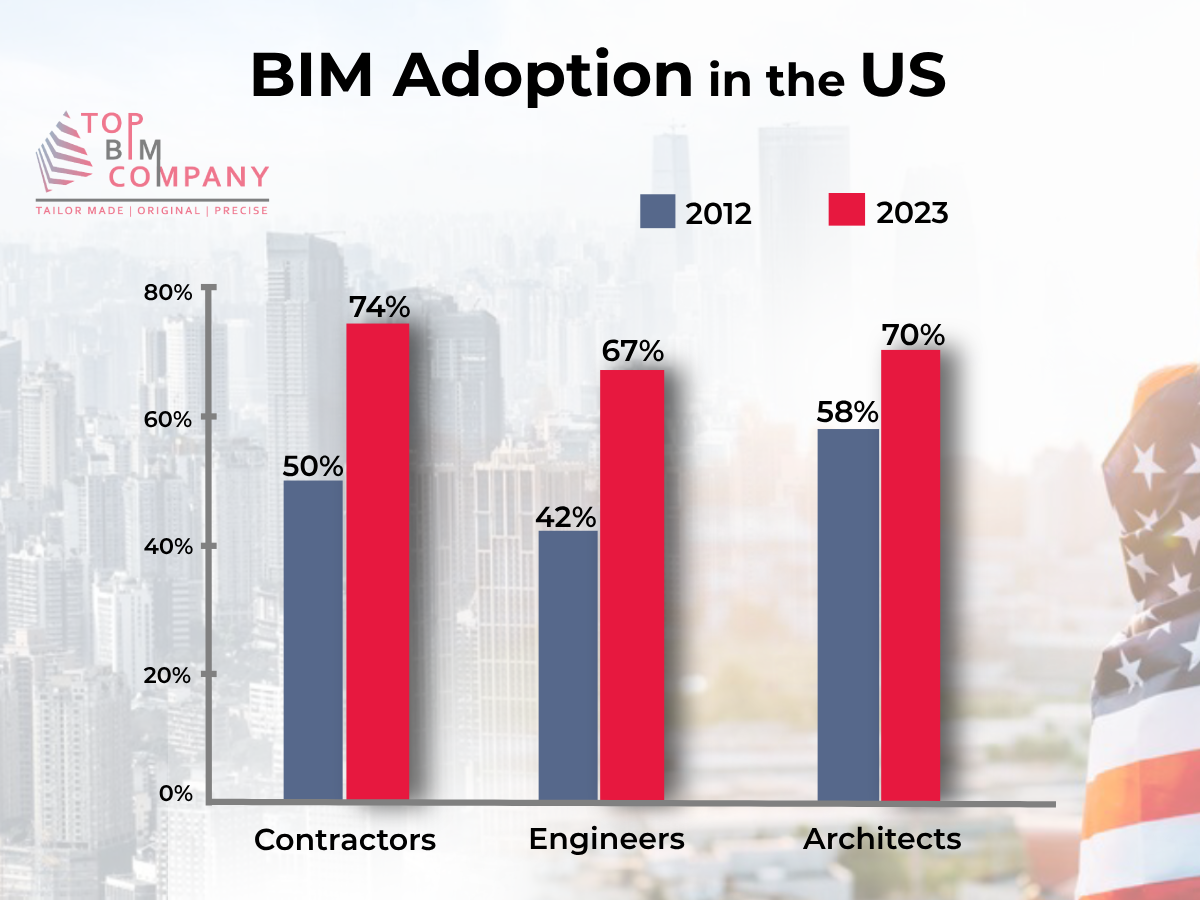
- Government Support: The federal government has played a crucial role in promoting BIM adoption, mandating its use on federal projects since 2003. This has encouraged private sector clients to follow suit.
- Industry Leadership: Renowned construction companies, such as Turner Construction and AECOM, have embraced BIM, demonstrating its effectiveness and paving the way for wider adoption.
- Technological Advancements: Continuous advancements in BIM software and hardware have made the technology more accessible and user-friendly, further fueling its adoption.
Building Blocks of BIM: A Comprehensive Overview
To fully grasp the impact of BIM, it’s essential to understand its core principles and concepts:
- Integration: BIM eliminates the need for siloed data sources by integrating all building information into a single model, providing a holistic view of the project.
- Collaboration: BIM facilitates collaboration among all stakeholders, enabling seamless communication, coordination, and problem-solving.
- Visualization: BIM models can be transformed into 3D visualizations, allowing stakeholders to better understand the design and make informed decisions.
- Information-Rich: BIM models are packed with detailed information, which can be used for cost estimation, scheduling, and maintenance planning.
Foundations of Adoption:
The rise of BIM in the USA can be traced back to several key milestones:
- Early 2000s: The General Services Administration (GSA) mandates BIM use on federal projects, setting a precedent for the industry.
- 2007: Autodesk introduces Revit, a groundbreaking BIM software that gains widespread adoption.
- 2009: The National Institute of Building Sciences (NBS) publishes the National BIM Standard, providing a framework for BIM implementation.
- 2010s: BIM adoption accelerates, driven by growing recognition of its benefits and government initiatives.
The Rise of BIM: Historical Milestones: (To be made in the form on Infographics)
- 1957 — Pronto, first commercial computer-aided machining (CAM) software
- 1963 — Sketchpad, CAD with graphical user interface
- 1975 — Building Description System (BDS)
- 1977 — Graphical Language for Interactive Design (GLIDE)
- 1982–2D CAD
- 1984 — Radar CH
- 1985 — Vectorworks
- 1986 — Really Universal Computer-Aided Production System (RUCAPS)
- 1987 — ArchiCAD
- 1988 — Pro/ENGINEER
- 1992 — Building Information Model as official term
- 1993 — Building Design Advisor
- 1994 — miniCAD
- 1995 — International Foundation Class (IFC) file format
- 1997 — ArchiCAD’s Teamwork
- 1999 — Onuma
- 2000 — Revit
- 2001 — NavisWorks
- 2002 — Autodesk buys Revit
- 2003 — Generative Components
- 2004 — Revit 6 update
- 2006 — Digital Project
- 2007 — Autodesk buys NavisWorks
- 2008 — Parametricist Manifesto
- 2012 — formit
BIM across Sectors: Beyond Buildings
BIM’s impact extends beyond traditional buildings, finding applications in a wide range of sectors:
Infrastructure:
BIM has revolutionized the infrastructure sector in the USA by enabling efficient design, construction, and management of large-scale projects. It is widely used for projects such as:
- Roads and bridges: BIM facilitates the creation of 3D models of roads and bridges, allowing for better visualization, clash detection, and analysis of traffic flow.
- Tunnels: BIM is used to design and construct complex tunnel systems, ensuring safety, structural integrity, and integration with existing infrastructure.
- Railways: BIM plays a crucial role in the planning and construction of railways, optimizing track alignment, station layouts, and signaling systems.
Key issues and data for infrastructure in the USA
- Aging infrastructure: The USA faces a significant challenge with aging infrastructure, requiring extensive rehabilitation and modernization efforts. BIM can be instrumental in assessing the condition of existing infrastructure and developing effective renovation strategies.
- Sustainability: Infrastructure projects in the USA are increasingly focused on sustainability, and BIM can help incorporate eco-friendly design principles and reduce the environmental impact of construction activities.
- Resilience: Infrastructure in the USA is vulnerable to natural disasters and extreme weather events. BIM can be used to design resilient infrastructure that can withstand and recover from such events.
Oil and Gas
The oil and gas industry in the USA relies heavily on BIM for designing, constructing, and operating complex facilities. BIM applications in this sector include:
- Offshore platforms: BIM is used to design and construct offshore platforms, ensuring structural stability, safety, and integration with marine environments.
- Pipelines: BIM facilitates the design and construction of extensive pipeline networks, ensuring compliance with safety regulations and environmental considerations.
- Processing plants: BIM is used to design and construct complex oil and gas processing plants, optimizing layout, process flow, and maintenance access.
Key issues and data for oil and gas in the USA
- Safety: The oil and gas industry prioritizes safety, and BIM can help identify and mitigate potential hazards in the design and construction phases.
- Environmental impact: Oil and gas operations can have environmental repercussions, and BIM can be used to minimize the environmental footprint of projects.
- Efficiency and productivity: The oil and gas industry strives for efficiency and productivity, and BIM can streamline processes, reduce waste, and optimize resource utilization.
Healthcare
BIM is transforming the healthcare sector in the USA by enabling efficient planning, construction, and management of healthcare facilities. BIM applications in this sector include:
- Hospitals: BIM is used to design and construct hospitals, optimizing patient flow, layout of medical departments, and integration of medical equipment.
- Clinics: BIM facilitates the design and construction of clinics, ensuring efficient workflows, patient privacy, and compliance with healthcare regulations.
- Research facilities: BIM is used to design and construct medical research facilities, ensuring flexibility, adaptability to future needs, and integration of complex laboratory equipment.
Key issues and data for healthcare in the USA:
- Patient safety: Patient safety is paramount in healthcare, and BIM can help design facilities that minimize infection risks, promote patient safety, and facilitate emergency response.
- Efficiency and cost-effectiveness: Healthcare providers face increasing cost pressures, and BIM can help optimize facility design, reduce construction costs, and improve operational efficiency.
- Adaptability to future needs: The healthcare landscape is constantly evolving, and BIM can facilitate future modifications and expansions to healthcare facilities.
Facilities Management
BIM is widely adopted in the USA for managing and maintaining existing buildings, optimizing operations and prolonging asset lifespan. BIM applications in facilities management include:
- Space management: BIM models provide a comprehensive overview of building spaces, enabling efficient allocation and utilization of space.
- Maintenance planning: BIM models facilitate the development of preventive maintenance schedules, reducing downtime and extending the lifespan of building components.
- Energy efficiency: BIM can be used to analyze energy usage patterns and identify opportunities for energy conservation in buildings.
Key issues and data for facilities management in the USA:
- Building aging: Many buildings in the USA are aging, requiring ongoing maintenance and upgrades. BIM can help prioritize maintenance tasks, optimize resource allocation, and extend the life of buildings.
- Energy efficiency: Energy consumption in buildings is a significant concern, and BIM can help identify and implement energy-saving measures.
- Sustainability: Sustainable building management practices are gaining traction in the USA, and BIM can support initiatives to reduce environmental impact and improve building sustainability.
We will create integrated and customized preconstruction BIM Model to turn your Vision into Reality
Government Backing and Initiatives: The Power of Policy
According to Allied Market Research Global BIM market growth is propelled by government policies mandating BIM solutions in construction, with North America requiring BIM for commercial projects.
The UK, Singapore, and the UAE have similar mandates, and Germany aims for BIM in all infrastructure projects by 2020-end. Denmark, Spain, and Italy have achieved high adoption rates. Positive government initiatives are key drivers for BIM market growth worldwide.
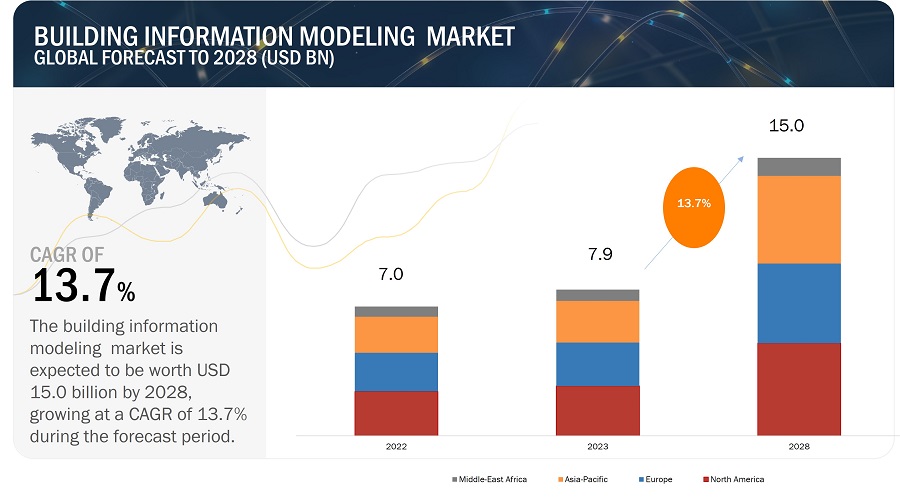
Image Source:marketsandmarkets
The US government has actively supported BIM adoption through various initiatives:
- BIM Mandate: The GSA’s BIM mandate has had a significant impact on BIM adoption in the industry.
- BIM Grants: The government has provided grants to support BIM research and development.
- BIM Advocacy: Government agencies have promoted BIM through workshops, conferences, and other educational initiatives.
Innovations and Technology Synergy: BIM 2.0:
BIM is constantly evolving, with emerging technologies being integrated to enhance its capabilities:
- Artificial Intelligence (AI): AI is being used to automate tasks, analyze data, and optimize design decisions.
- Internet of Things (IoT): BIM models are being integrated with IoT sensors to collect real-time data for building performance monitoring.
- Augmented Reality (AR): AR is used to overlay BIM models onto real-world environments, enhancing visualization and collaboration.
BIM’s Impact on Efficiency:
Construction Revolution: How BIM Drives Efficiency?
Building Information Modeling (BIM) has revolutionized the construction industry by introducing a digital, collaborative, and information-rich approach to project delivery. This has led to significant improvements in efficiency, reducing costs, shortening project schedules, and enhancing building quality.
Realizing Cost Savings and Timely Delivery:
Studies have consistently shown that BIM can lead to substantial cost savings and project schedule reductions. A Dodge Data & Analytics study found that BIM can reduce project costs by up to 20% and project schedules by up to 10%.
As per planradar.com, BIM adoption in the US AEC industry yields significant benefits:
- 25% improvement in labor productivity
- 25% reduction in labor costs
- 5% lower final construction costs
- 5% faster project completion, as per Dodge Data & Analytics research.
These savings are primarily achieved through:
- Improved Design Coordination: BIM facilitates early detection and resolution of design clashes, preventing costly rework during construction.
- Enhanced Communication and Collaboration: BIM provides a single platform for sharing and exchanging information, streamlining communication and reducing miscommunication.
- Reduced Errors and Omissions: BIM’s comprehensive modeling and analysis capabilities help identify and eliminate errors early in the design process, preventing costly rework later.
Green Building and Sustainability:
BIM’s Green Agenda: Sustainable Construction Practices:
BIM is playing a crucial role in promoting sustainable construction practices and contributing to the development of green buildings. BIM’s ability to integrate and analyze data enables the design of energy-efficient, resource-efficient, and environmentally friendly buildings.
A Greener Future with BIM-Enabled Eco-Design:
BIM facilitates the implementation of eco-design principles by:
- Optimizing Building Performance: BIM models can be used to analyze energy consumption, water usage, and environmental impact, guiding design decisions towards sustainability.
- Materials Selection and Optimization: BIM can be used to assess the environmental impact of building materials and identify sustainable alternatives.
- Waste Reduction and Efficient Construction: BIM can optimize construction processes to minimize waste and promote efficient resource utilization.
Training and Skill Development:
- From Blueprint to Digital Model: Training the BIM Workforce:
The widespread adoption of BIM has created a demand for a skilled BIM workforce. This has led to the development of various training programs and certifications to equip professionals with the necessary skills and knowledge.
- Bridging the Skills Gap: The BIM Professional:
BIM professionals possess a unique blend of technical and design expertise, enabling them to effectively utilize BIM software and contribute to the successful implementation of BIM projects.
BIM in the Smart City Era:
Connected Cities, Informed Citizens: BIM’s Role in Urban Transformation:
BIM is playing an increasingly important role in the development of smart cities. BIM models can be integrated with citywide infrastructure data to create a comprehensive digital representation of the urban environment.
This digital twin can be used for:
- Urban Planning and Design: BIM facilitates informed decision-making for urban planning and design, optimizing infrastructure placement and resource allocation.
- Smart Building Management: BIM models can be used to manage and optimize the performance of smart buildings, reducing energy consumption and enhancing occupant comfort.
- Public Engagement and Citizen Participation: BIM can be used to create interactive visualizations that engage citizens in urban planning discussions, promoting transparency and participatory decision-making.
Projects Fueled by BIM in USA:
The diverse projects exemplify the widespread use of BIM across the US, showcasing its adaptability in various building types and its contribution to streamlined and efficient construction processes.
- St Louis Aquarium, St Louis, MO: Leveraging BIM, this project innovatively designed an aquarium within St Louis Union Station while preserving its historical structure. The software facilitated modeling visitor perspectives, intricate piping, and life support systems, showcasing BIM’s versatility.
- Good Samaritan Hospital, Puyallup, WA: Awarded LEED Gold Certification for its eco-friendly features, this nine-story inpatient hospital tower utilized 3D modeling software. BIM streamlined the design-to-construction transition, minimizing errors and enhancing efficiency in this green-certified healthcare facility.
- Southwest School of Behavioral and Social Sciences, Los Angeles, CA: As part of the LACCD project, this sustainable redesign transformed a three-story building in the school’s social science department. BIM played a crucial role in reducing redesigns and rework, saving both time and money in the renovation of this educational facility.
BIM Automation For Building 3D Modeling and Design
Our BIM Experts will provide a customized solution & cost estimation for your project.
Challenges and Obstacles in USA
Navigating Hurdles: Regulatory, Security, and Privacy Concerns:
Despite its transformative potential, BIM implementation faces certain challenges:
- Regulatory Framework: The regulatory landscape surrounding BIM adoption in USA varies across regions and jurisdictions, requiring careful consideration of legal and compliance requirements.
- Data Security and Privacy: BIM models contain sensitive information about buildings and their occupants, raising concerns about data security and privacy protection.
- Cultural Change and Organizational Barriers: Adapting to BIM’s digital workflows in USA can be challenging for traditional construction organizations, requiring a shift in mindset and cultural change.
Overcoming Technological Roadblocks in USA:
The rapid evolution of BIM technology can pose challenges for organizations, such as:
- Software and Hardware Compatibility: Ensuring compatibility between different BIM software applications and hardware systems is crucial for seamless collaboration.
- Integration with Existing Systems: BIM models need to integrate effectively with existing project management and financial systems to streamline workflows.
- Continuous Learning and Training: Keeping up with the latest BIM advancements requires ongoing training and professional development for BIM professionals.
Showcasing Success: BIM Triumphs
The American Dream in BIM: Remarkable Projects:
The USA is home to numerous remarkable BIM-enabled projects that showcase the technology’s transformative power:
- One World Trade Center: BIM played a crucial role in the reconstruction of One World Trade Center, ensuring structural integrity and collaboration among hundreds of stakeholders. One World Trade Center, the tallest in the Western Hemisphere, not only stands as a symbol of resilience at ground zero but also sets safety standards, becoming a model for future high-rise construction.

- Levi’s Stadium: BIM was instrumental in the design and construction of Levi’s Stadium, enabling efficient coordination of complex architectural and engineering elements. Cupertino’s in-house engineering and BIM teams efficiently managed the stadium’s electrical design, completing it two months ahead of schedule and well within the construction budget.
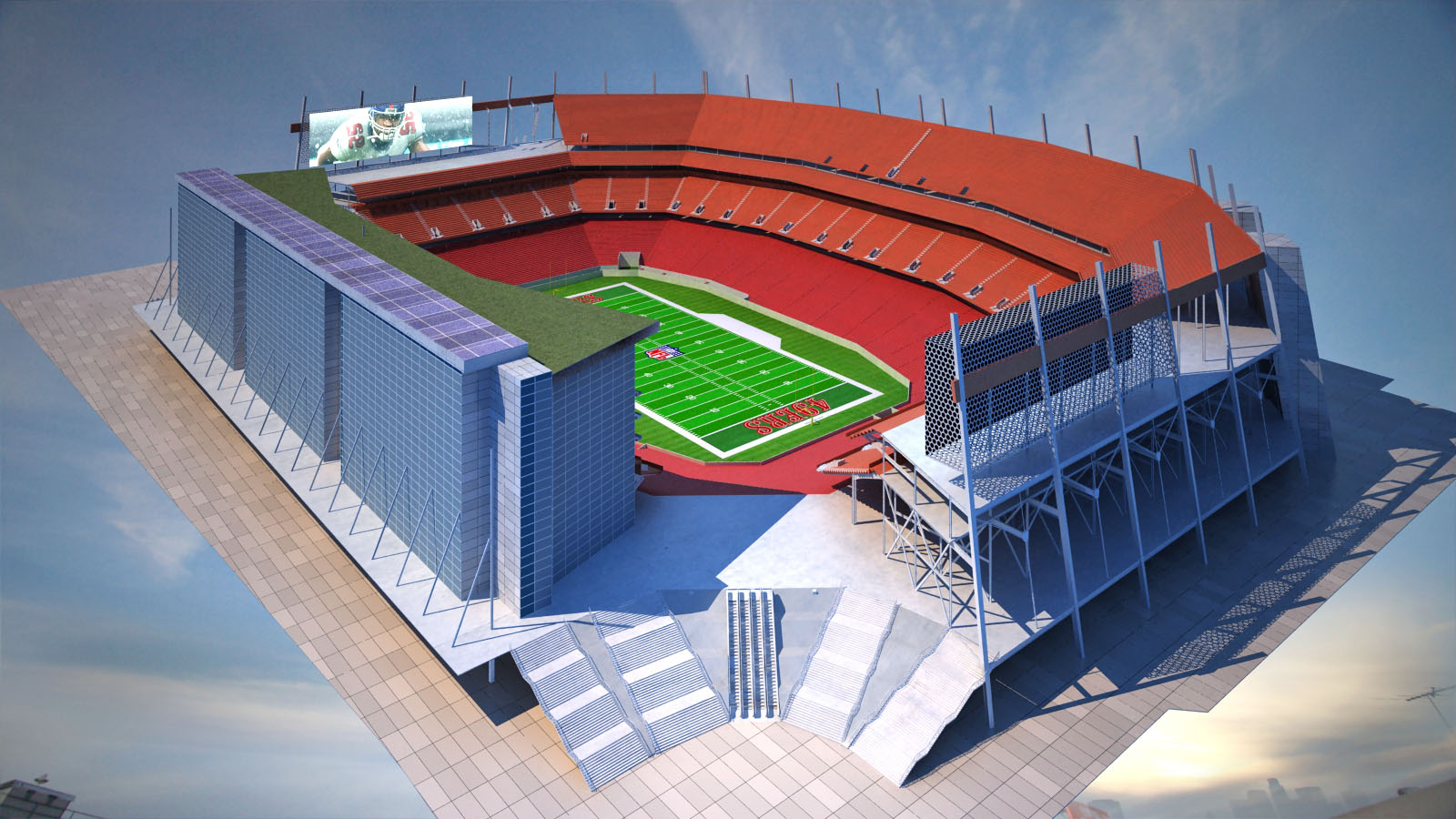
- The Children’s Hospital of Philadelphia: BIM facilitated the expansion of the Children’s Hospital of Philadelphia, ensuring optimal patient care and minimizing disruption to existing operations. Efficient BIM modeling guided structure and curtain wall preconstruction. MEP systems were seamlessly coordinated across design, preconstruction, and construction phases, enabling substantial prefabrication. This enhanced safety, adhered to schedule, and elevated work quality.

Innovations and Breakthroughs in the USA
The USA is at the forefront of BIM innovation, with several notable breakthroughs that are transforming the construction industry:
- OpenBIM: OpenBIM is a set of standards and guidelines that promote interoperability and collaboration among different BIM software applications. This means that different teams can work on the same BIM model using different software, without losing data or experiencing any compatibility issues. OpenBIM has been a major breakthrough in the BIM industry, as it has made it much easier for project teams to collaborate effectively. https://www.drofus.com/es/openbim
- Cloud-Based BIM: The adoption of cloud-based BIM platforms is another major trend in the USA. Cloud-based BIM platforms allow project teams to access and work on BIM models from anywhere in the world, using any device. This has made it much easier for teams to collaborate remotely, and has also made it easier to manage and share BIM data. https://www.researchgate.net/figure/System-Diagram-of-the-Cloud-Based-BIM-Platform_fig1_315741349
- BIM-Integrated IoT: The integration of BIM with IoT (Internet of Things) sensors is a new and exciting development in the USA. IoT sensors can be embedded in buildings to collect data on a wide range of factors, such as temperature, humidity, occupancy, and energy consumption. This data can then be integrated into BIM models, providing valuable insights into building performance. This information can be used to optimize building operations, improve energy efficiency, and enhance occupant comfort.
Future Horizon: What Lies Ahead?
The Road Ahead: Trends Shaping BIM’s Future in the USA:
BIM is poised to play an even more significant role in the future of the construction industry, driven by several emerging trends:
- Generative Design: AI-powered generative design tools will revolutionize the design process, allowing architects and engineers to explore and optimize design options more effectively.
- Virtual Reality (VR) and Augmented Reality (AR): VR and AR technologies will enhance collaboration and communication, enabling stakeholders to interact with BIM models in real-time and experience the built environment virtually.
- Data-Driven Construction: BIM data will be leveraged to optimize construction processes, predict potential issues, and improve project outcomes, driving smarter decision-making and resource allocation.
- Integrated Project Delivery (IPD): BIM will facilitate IPD, fostering seamless collaboration and information sharing among all project stakeholders, breaking down silos and streamlining project delivery.
- Digital Twins: BIM models will evolve into digital twins, providing real-time data and insights for building performance optimization, enabling predictive maintenance, energy efficiency maximization, and occupant comfort enhancement.
- Predictive Analytics: BIM data will be used for predictive analytics, enabling proactive identification and mitigation of potential issues, optimizing building operations, and reducing maintenance costs.
Final Thought
The USA is at the forefront of BIM adoption, and its impact on the construction industry is undeniable. As BIM continues to evolve, it will undoubtedly shape the future of the built environment, leading to more efficient, sustainable, and innovative buildings.
BIM is transforming the construction industry in the USA, addressing challenges such as regulatory complexity, data security, and cultural change. It promotes collaboration, efficiency, and innovation, shaping the future of the built environment.
BIM addresses challenges in USA market by providing a centralized platform for managing and sharing project data, incorporating robust security measures, promoting collaboration and information sharing, and facilitating remote access and data sharing.
We are a leading provider of BIM Services in the USA. From customized BIM consulting services to BIM Execution Plans (BEP), we can be your one-stop shop for your BIM needs
Further Reading:
- What Is BIM? Guide To Implementation And Myths
- Innovative BIM Modeling Trends Shaping AEC Industry
- BIM Adoption Challenges In Construction Industry
- The Future Of BIM Construction- Trends, Challenges & Adoption
- Applications Of BIM Technology In The Construction Industry
- Competitive Advantages Of BIM Automation In The AEC Industry
- BIM Collaboration- For Successful Project Implementation
Our Services
Latest Post
Get A Free Quote
BIM Construction is the Future
Building information modeling (BIM) is the future of building design and construction. Get in touch with our BIM Experts.

